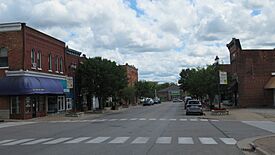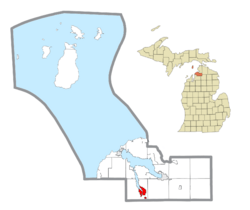East Jordan, Michigan facts for kids
Quick facts for kids
East Jordan, Michigan
|
|
|---|---|
| City of East Jordan | |

Looking north along Main Street
|
|
| Motto(s):
"Where River, Lake, and Friendly People Meet"
|
|

Location within Charlevoix County
|
|
| Country | United States |
| State | Michigan |
| County | Charlevoix |
| Settled | 1873 |
| Incorporated | 1887 (village) 1911 (city) |
| Government | |
| • Type | City commission |
| Area | |
| • Total | 3.92 sq mi (10.15 km2) |
| • Land | 3.00 sq mi (7.77 km2) |
| • Water | 0.92 sq mi (2.38 km2) |
| Elevation | 646 ft (197 m) |
| Population
(2020)
|
|
| • Total | 2,239 |
| • Density | 746.33/sq mi (288.19/km2) |
| Time zone | UTC-5 (Eastern (EST)) |
| • Summer (DST) | UTC-4 (EDT) |
| ZIP code(s) |
49727
|
| Area code(s) | 231 |
| FIPS code | 26-24020 |
| GNIS feature ID | 0625200 |
East Jordan is a city in Charlevoix County in the U.S. state of Michigan. The population was 2,239 at the 2020 census.
The city is at the end of the south arm of Lake Charlevoix at the mouth of the Jordan River. The corporate headquarters of EJ, an international company formerly known as East Jordan Iron Works, is located in East Jordan. EJ was founded in East Jordan in 1883.
History
The area was first settled by Canadian William Empey in 1873. He built the first store here in 1874 at the mouth of the Jordan River at the southernmost point of Lake Charlevoix. He became the first postmaster when the post office opened on May 31, 1878. The community absorbed the nearby village of South Arm and incorporated as the village of East Jordan in 1887. It incorporated as a city in 1911.
East Jordan grew quickly, and by 1890, it boasted a large ironworks company now known as EJ. The city was serviced by two railroads. With these two railroad connections, and the ability to ship cargo up Lake Charlevoix to Lake Michigan, East Jordan quickly grew into a major manufacturing center. To this day, four industrial corporations still operate within the town. In 1899, the Detroit and Charlevoix Railroad built their mainline through the East side of the city, and in 1901, the East Jordan and Southern Railroad began operations on the western end of the city. In 1932, the Detroit and Charlevoix was abandoned, and the East Jordan and Southern closed in 1961 after the East Jordan Iron Works ended shipping by rail.
East Jordan contains two listing on the National Register of Historic Places. The East Jordan Lumber Company Store Building and the Votruba Block were both built in 1899 and are located next to each other in the city's downtown area.
Geography
According to the U.S. Census Bureau, the city has a total area of 3.92 square miles (10.15 km2), of which 3.00 square miles (7.77 km2) is land and 0.92 square miles (2.38 km2) (23.47%) is water.
The city boundaries contain an exclave which is used to incorporate the East Jordan City Airport to the southeast of the city.
Major highways
 M-32 enters the city from the east and has its western terminus at M-66. within East Jordan.
M-32 enters the city from the east and has its western terminus at M-66. within East Jordan. M-66 runs south–north through the western portion of the city.
M-66 runs south–north through the western portion of the city. C-48 is a county-designated highway that runs through the center of the city and briefly concurrent with M-32.
C-48 is a county-designated highway that runs through the center of the city and briefly concurrent with M-32.
Climate
This climatic region has large seasonal temperature differences, with warm to hot (and often humid) summers and cold (sometimes severely cold) winters. According to the Köppen Climate Classification system, East Jordan has a humid continental climate, abbreviated "Dfb" on climate maps.
| Climate data for East Jordan, Michigan (1991–2020 normals, extremes 1926–present) | |||||||||||||
|---|---|---|---|---|---|---|---|---|---|---|---|---|---|
| Month | Jan | Feb | Mar | Apr | May | Jun | Jul | Aug | Sep | Oct | Nov | Dec | Year |
| Record high °F (°C) | 55 (13) |
65 (18) |
87 (31) |
90 (32) |
97 (36) |
102 (39) |
103 (39) |
100 (38) |
97 (36) |
88 (31) |
78 (26) |
65 (18) |
103 (39) |
| Mean daily maximum °F (°C) | 30.4 (−0.9) |
32.9 (0.5) |
42.9 (6.1) |
56.0 (13.3) |
70.0 (21.1) |
79.2 (26.2) |
82.6 (28.1) |
80.9 (27.2) |
73.7 (23.2) |
60.3 (15.7) |
46.5 (8.1) |
35.4 (1.9) |
57.6 (14.2) |
| Daily mean °F (°C) | 22.7 (−5.2) |
23.6 (−4.7) |
32.0 (0.0) |
43.6 (6.4) |
55.7 (13.2) |
65.0 (18.3) |
68.9 (20.5) |
67.4 (19.7) |
60.6 (15.9) |
49.4 (9.7) |
38.4 (3.6) |
28.8 (−1.8) |
46.3 (7.9) |
| Mean daily minimum °F (°C) | 15.1 (−9.4) |
14.2 (−9.9) |
21.1 (−6.1) |
31.2 (−0.4) |
41.4 (5.2) |
50.8 (10.4) |
55.2 (12.9) |
53.8 (12.1) |
47.5 (8.6) |
38.4 (3.6) |
30.3 (−0.9) |
22.3 (−5.4) |
35.1 (1.7) |
| Record low °F (°C) | −36 (−38) |
−41 (−41) |
−29 (−34) |
−7 (−22) |
13 (−11) |
26 (−3) |
33 (1) |
30 (−1) |
23 (−5) |
15 (−9) |
−14 (−26) |
−31 (−35) |
−41 (−41) |
| Average precipitation inches (mm) | 2.04 (52) |
1.34 (34) |
1.54 (39) |
2.52 (64) |
2.98 (76) |
3.15 (80) |
2.90 (74) |
3.26 (83) |
3.74 (95) |
4.37 (111) |
2.76 (70) |
2.24 (57) |
32.84 (834) |
| Average snowfall inches (cm) | 37.4 (95) |
23.1 (59) |
11.0 (28) |
4.6 (12) |
0.0 (0.0) |
0.0 (0.0) |
0.0 (0.0) |
0.0 (0.0) |
0.0 (0.0) |
0.7 (1.8) |
10.0 (25) |
35.4 (90) |
122.2 (310) |
| Average precipitation days (≥ 0.01 in) | 17.3 | 12.4 | 9.5 | 11.4 | 11.5 | 10.4 | 9.8 | 10.0 | 11.3 | 14.6 | 14.6 | 16.1 | 148.9 |
| Average snowy days (≥ 0.1 in) | 15.6 | 11.0 | 5.5 | 2.2 | 0.1 | 0.0 | 0.0 | 0.0 | 0.0 | 0.4 | 5.0 | 12.5 | 52.3 |
| Source: NOAA | |||||||||||||
Demographics
| Historical population | |||
|---|---|---|---|
| Census | Pop. | %± | |
| 1890 | 731 | — | |
| 1900 | 1,205 | 64.8% | |
| 1910 | 2,516 | 108.8% | |
| 1920 | 2,428 | −3.5% | |
| 1930 | 1,523 | −37.3% | |
| 1940 | 1,725 | 13.3% | |
| 1950 | 1,779 | 3.1% | |
| 1960 | 1,919 | 7.9% | |
| 1970 | 2,041 | 6.4% | |
| 1980 | 2,185 | 7.1% | |
| 1990 | 2,240 | 2.5% | |
| 2000 | 2,507 | 11.9% | |
| 2010 | 2,351 | −6.2% | |
| 2020 | 2,239 | −4.8% | |
| U.S. Decennial Census | |||
2010 census
As of the census of 2010, there were 2,351 people, 952 households, and 613 families residing in the city. The population density was 770.8 inhabitants per square mile (297.6/km2). There were 1,189 housing units at an average density of 389.8 per square mile (150.5/km2). The racial makeup of the city was 96.0% White, 0.2% African American, 1.6% Native American, 0.1% Asian, 0.3% from other races, and 1.8% from two or more races. Hispanic or Latino people of any race were 2.3% of the population.
There were 952 households, of which 35.6% had children under the age of 18 living with them, 43.2% were married couples living together, 14.3% had a female householder with no husband present, 6.9% had a male householder with no wife present, and 35.6% were non-families. 29.7% of all households were made up of individuals, and 13.5% had someone living alone who was 65 years of age or older. The average household size was 2.46 and the average family size was 3.01.
The median age in the city was 37.1 years. 27.1% of residents were under the age of 18; 7.8% were between the ages of 18 and 24; 25.4% were from 25 to 44; 24.5% were from 45 to 64; and 15.2% were 65 years of age or older. The gender makeup of the city was 48.7% male and 51.3% female.
Education
East Jordan is served by its own school district, East Jordan Public Schools, which is centered in the city and serves larger portions of several townships.
See also
 In Spanish: East Jordan para niños
In Spanish: East Jordan para niños





